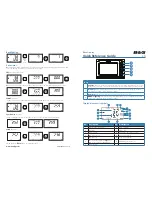
Using the Multiport Test System
How to Characterize Active Devices
Chapter 3
58
How to Characterize Active Devices
Set the input power level using the source power and/or attenuator settings (N4413A and
N4414A only) to compensate for the expected gain of the DUT. Keep in mind the saturation
level of the DUT and the input power limits and damage level of the test set and analyzer.
Some system models have a provision for biasing the DUT through the test ports. In this case,
bias voltages are applied to the bias inputs on the rear of the test set.
Active Device Measurement Example
This example shows the characterization of a 27 dB gain amplifier with a +10 dBm
compression point. Measurements were made to show gain, isolation, and match.
The system was calibrated with the following Measurement Parameters (as shown below):
•
−
30 dBm output level (10 dBm source power, 10 dB of test set path loss, and 30 dB of
attenuation)
• Frequencies from 800 MHz to 1000 MHz with 5 MHz steps
The bias was set for 6 V
DC
directly on the power supply.
Summary of Contents for N4413A
Page 4: ...iv ...
Page 11: ...1 1 About the Multiport Test System ...
Page 18: ...About the Multiport Test System Available Options and Accessories Chapter 1 8 ...
Page 19: ...9 2 User Interface ...
Page 27: ...17 3 Using the Multiport Test System ...
Page 89: ...79 4 Performing Time Domain Measurements ...
Page 109: ...99 5 Menu Reference ...
Page 163: ...153 6 Maintenance and Troubleshooting ...
Page 172: ...Maintenance and Troubleshooting Contacting Agilent Chapter 6 162 ...
Page 173: ...163 7 Instrument Information ...
Page 208: ...Instrument Information Specifications and Characteristics Chapter 7 198 ...
Page 209: ...199 8 Safety and Regulatory Information ...
Page 218: ...Safety and Regulatory Information Regulatory Information Chapter 8 208 ...
Page 219: ...209 A Other Technical Procedures ...
Page 224: ...Other Technical Procedures IF Gain Adjustment Appendix A 214 ...
















































